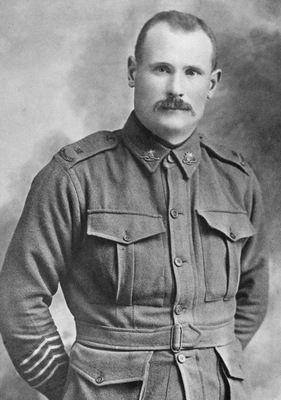A century on from the end of World War I we acknowledge their service …
Lest we forget.
Lance Corporal Robert Slessar
Born: 1886 Waaia, Vic. Killed in action: 27 August 1916 Pozieres.
Enlisted: 9 July 1915 aged 29.
Served: Egypt and Western Front.
Bob was the son of Robert Slessar Senior and Mary Grierson Slessar of “Oak Bank” Pakenham. Described as “exceptionally popular”, he was an engineer by trade and had been an agent, salesman and field expert specialising in threshing machines for Massey Harris, a farm implements manufacturer. Bob had also done a stint as an overseer at Buckingbong where his employer noted he was very capable with agriculture, stock and farm machinery and had proved himself to be honest, trustworthy and “completely sober”.
Around 1911, Bob went into partnership with Harry Worship of Pakenham South, establishing “Worship and Slessar” a land, finance and general agency in Pakenham East. Bob was also actively involved in a range of local community activities, including the Pakenham Social Club, which was set up by the “younger set” to organise local dances and other entertainment. He also played district cricket for Pakenham and was a keen cyclist.
Bob was 29 when he enlisted on 9 July 1915, just a few months after the initial Anzac landings at Gallipoli. At the time, it was noted the district was “doing remarkably well in the number that it has sent to the Front”. Bob was initially assigned to the 1st Reinforcement, 6th Field Company Engineers as a sapper. He left Australia in November 1915, bound for Egypt. From there, he proceeded to the Western Front in France.
On 27 July 1916, Bob was wounded in action, but remained at duty. In August, he was promoted to Lance Corporal with No 3 Section, 6th Field Company, but was killed in action on 27 August 1916 during the Battle of Pozieres.
The circumstances of his death were recorded by a mate who served with him: “I knew Bob Slessar well … he was killed in the second stunt between Pozieres and Le Mouquet Farm … We were digging a sap (a narrow trench used by soldiers to advance on the enemy) out of the quarry into No Man’s Land to bring in a lot of men who were holding scattered shell holes. Slessar was one of the last to go out. He had to pass me where I lay digging – and several beyond me – in order to get to this position. As he passed I told him to keep low as they (the Germans) were sniping. Further on he got hit as he was getting out of a shell hole. Those nearest to him crawled to him, and told me he was killed outright, and they buried him by the side of the sap as they dug … Slessar was a very fine fellow – liked by everyone in the company”.
Meanwhile back home, Bob’s father had died in early August following a long illness. In September, Mary Slessar received notification from the Department of Defence that Bob had been wounded, but no other details were available. The letter continued: “It is not stated as being serious and in the absence of further reports it is assumed that all wounded are progressing satisfactorily”. This presumably related to Bob’s first wounding. He was subsequently reported as missing. Confirmation of Bob’s death reached Pakenham in early November 1916, at the same time as word that another Pakenham Upper Digger, “Rich” Copeland had also been killed.
This is an extract from Patrick Ferry’s book A Century After The Guns Fell Silent – Remembering the Pakenham District’s WWI Diggers 1914-18.
For more details on this and other profiles in the book, head to the website www.pakenhamww1.com







